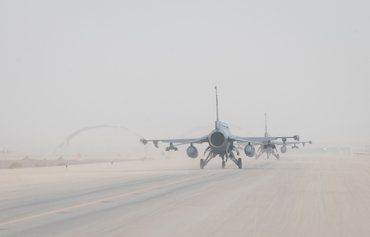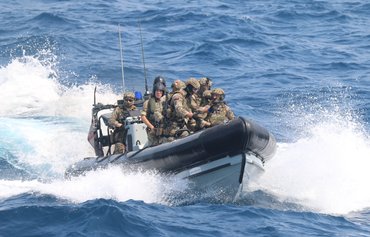An ongoing bilateral military exercise involving US and Saudi forces is sending the message that the two nations continue to stand together in the face of persistent regional security threats.
Falcon Claw IV, the bilateral exercise with Royal Saudi Land Forces and the US Army, began on June 8 in the northwestern region of Saudi Arabia and is ongoing as of Tuesday (June 22).
The exercise is aimed at strengthening military relations between the two countries and exchanging expertise and concepts, in addition to raising combat readiness to face external threats, reported the official Saudi Press Agency (SPA).
"We have a strong understanding with... our allies about the threat in the region," Arab coalition spokesman and Saudi officer Turki al-Maliki said June 18.
![US and Saudi troops participate in a bilateral exercise in a photo posted on June 20. [Saudi Ministry of Defense]](/cnmi_am/images/2021/06/22/30422-e4v-grfxwae8bpy-600_384.jpg)
US and Saudi troops participate in a bilateral exercise in a photo posted on June 20. [Saudi Ministry of Defense]
![Soldiers take part in the Falcon Claw IV joint exercise in northwest Saudi Arabia in this picture posted June 9 on Twitter. [Saudi Ministry of Defence/Twitter]](/cnmi_am/images/2021/06/22/30356-falconclaws2__1_-600_384.jpg)
Soldiers take part in the Falcon Claw IV joint exercise in northwest Saudi Arabia in this picture posted June 9 on Twitter. [Saudi Ministry of Defence/Twitter]
Gulf Co-operation Council (GCC) member Saudi Arabia is leading a coalition -- that includes other members of the bloc, notably the UAE -- in support of Yemen's internationally recognised government. The Iran-backed Houthis are pressing an offensive in the bloody, years-long conflict despite repeated appeals for ceasefires and peace talks.
The Falcon Claw IV drills have included indirect fire, command and control, offensive combat transport, explosive disposal training.
The United States and Saudi Arabia earlier on May 18-19 conducted the Desert Mirage III joint exercise at Prince Sultan Air Base.
The exercise included a number of trainings on joint combat scenarios to face off emerging threats and upgrade the level of joint combat readiness, the SPA reported.
It also sought to "deepen the ties of co-operation among the Saudi forces and the US forces, to reach the required deterrence to any possible attack that would threaten regional security and safety", it added.
The ongoing partnership was reiterated during CENTCOM commander Gen. Frank McKenzie's visit to Saudi Arabia on May 23.
"Saudi Arabia is a key partner in the Middle East, and an important pillar of the regional security architecture," McKenzie said, "and I am extremely proud of the strategic relationship we've built over the years."
Regional threats
The recent exercises demonstrate the ability of Saudi Arabia and the United States to counter threats by destabilising actors in the region, such as Iran's Islamic Revolutionary Guard Corps (IRGC), which funds and directs a host of proxies throughout the region.
In Iraq, Iran-backed militias have launched repeated rocket attacks at Western diplomatic personnel, coalition supply convoys and US troops.
Tehran also supports the Houthis in Yemen, who have launched several rocket and drone attacks against Saudi targets.
Saudi air defences on Saturday (June 19) intercepted a total of 17 explosives-laden drones fired at the kingdom from Yemen by Houthis, the most in a single day since the conflict began, the Arab coalition said.
"The interception operations were successful," the coalition said.
Seven of the drones targeted regions in southern Saudi Arabia, and three targeted the Khamis Mushayt region, the SPA reported.
Meanwhile, A bomb-laden drone launched by the Houthis crashed into a Saudi school in southern Asir province on June 13, according to SPA.
The Saudi-led coalition fighting the Houthis said earlier this month it had stopped carrying out attacks in Yemen in order to pave the way for a peaceful settlement.
The Houthis have led a months-long offensive to seize Marib and its surrounding oil fields -- the last significant pocket of government-held territory in the north.

![Soldiers take part in the Falcon Claw IV joint exercise in northwest Saudi Arabia in this picture posted June 20 on Twitter. [Saudi Ministry of Defence/Twitter]](/cnmi_am/images/2021/06/22/30404-falconclaws3-600_384.jpg)






